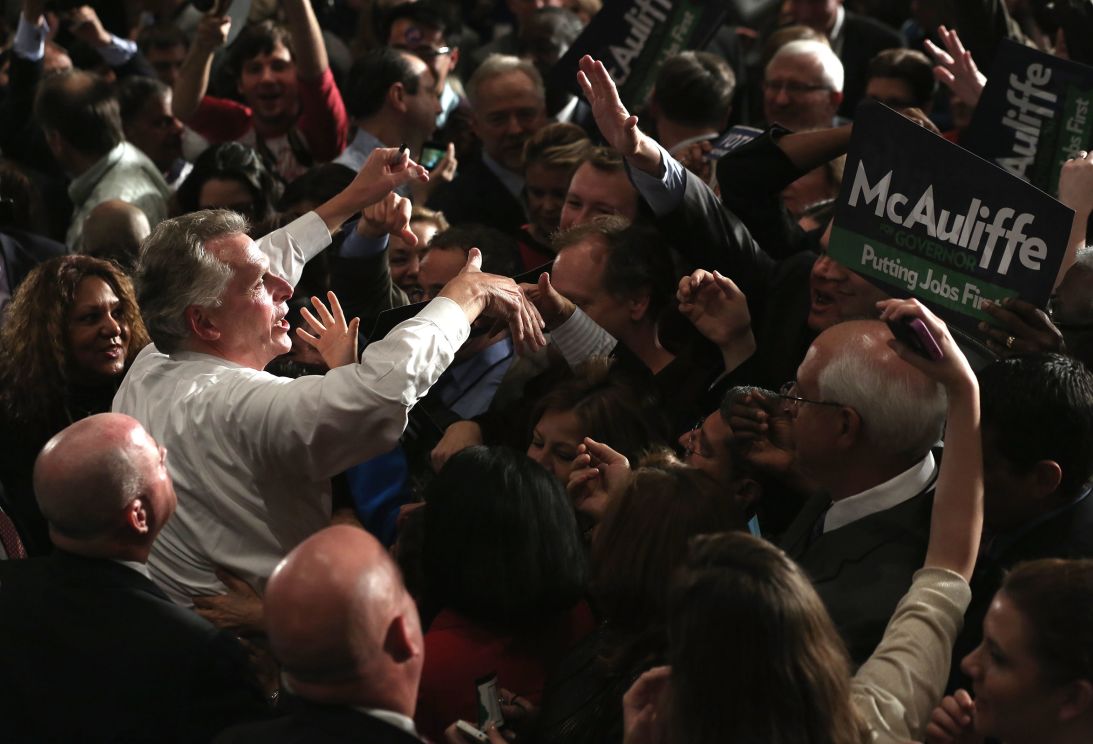The pivotal question in November’s New Jersey and Virginia governor races may be whether the outcome is shaped more by President Donald Trump’s electoral strengths or by his weaknesses.
Four years ago, the GOP candidates in both races benefited from one of Trump’s most important political gains: improving the GOP vote among working-class racial minorities. But they were able to minimize the impact of his most conspicuous political vulnerability: a shift away from the Republican Party in white-collar suburbs.
This year, though, the equation seems reversed. Heading into the final weeks, that dynamic has provided a consistent mid-single-digit edge in polls for Democratic nominee Mikie Sherrill in New Jersey and a wider advantage for Abigail Spanberger in Virginia.
On the one hand, in this off-off-year election, most experts agree that Republican nominees Jack Ciattarelli in New Jersey and Winsome Earle-Sears in Virginia face uphill climbs to activate the low-propensity voters — often younger and nonwhite — whom Trump mobilized in surprising number last year.
“The question for Republicans is: Are those very unique Trump voters that got him closer in New Jersey and Virginia and some other blue states (only) Trump voters or are they Republican voters?” said Mike DuHaime, a longtime New Jersey Republican strategist. “That is what will be answered this year.”
On the other, the Republican candidates could face much larger deficits next month in white-collar suburbs such as Fairfax County, Virginia, and Bergen County, New Jersey, than they did in 2021, when Joe Biden occupied the White House and Trump was much less visible. “We know through a lot of conversations and organizing … that those voters are frustrated and upset with what they are seeing from the Trump administration,” said Mini Timmaraju, president and CEO of Reproductive Freedom for All, a pro-abortion rights group.
Both sides believe New Jersey is a more competitive race than Virginia, partly because Ciattarelli is a stronger candidate than Earle-Sears, but also because Virginia more acutely feels the impact of the sweeping cutbacks in the federal workforce and contracting ranks engineered by Trump and by the formerly Elon Musk-fronted DOGE project.
Virginia is also easier for Democrats because Spanberger is running to replace Glenn Youngkin, the term-limited Republican governor whose approval rating has sagged somewhat, while Sherrill is trying to succeed Phil Murphy, the outgoing Democratic governor, whose ratings have also drooped. If Sherrill wins, it will mark the first time since the 1960s that the same party has won three consecutive New Jersey gubernatorial elections.
Even so, in recent decades, both states have almost always chosen governors from the party that lost the White House the year before — especially when the new president faces as much disapproval for his job performance as Trump does now.
“If you’ve got a president of your own party at minus 13 to minus 15 (job approval) in an off-off-year, it’s always significant,” said Democratic activist Terry McAuliffe. McAuliffe should know: He narrowly won election as Virginia’s governor in 2013 while Barack Obama’s approval was faltering amid the rocky rollout of the Affordable Care Act, and then lost a comeback bid to Youngkin in 2021 as Biden’s rating cratered in the aftermath of the disastrous withdrawal from Afghanistan.

Lessons from 2017 and 2021
McAuliffe’s close win in 2013 was the only time since 1973 that Virginia elected a governor from the party that won the White House the previous year. The pattern hasn’t been quite as inviolate in New Jersey, but the only gubernatorial candidates from the same party as the president who have won there in recent decades were Murphy in 2021 and moderate Republican Tom Kean during Ronald Reagan’s presidency in 1981 and 1985.
Inevitably, local issues have shaped the outcome of these contests. But on many occasions, the New Jersey and Virginia contests have prefigured shifts in both the national arguments between the parties and the allegiances of key voter blocks. On several recent occasions, that has made them an early gauge of tremors that rumble through the next midterm and even presidential elections.
“To a great extent, both parties look at (these elections) as kind of spring training, but also as a harbinger,” said Tom Davis, a former Republican representative from Northern Virginia who chaired the National Republican Congressional Committee during his years in the chamber.
That role is evident in the oscillating recent signals from these governors’ races in the well-educated suburbs of both states.
In the 2017 governor races, against the backdrop of Trump’s tumultuous first year in office, those places played a key role in the resounding victories of Democrats Ralph Northam in Virginia and Phil Murphy in New Jersey. In Virginia, Northam carried the four big suburban Northern Virginia jurisdictions — Arlington, Fairfax, Loudoun and Prince William counties — by a crushing 242,000-vote margin. That was more than double McAuliffe’s advantage in those same places four years earlier. Northam also comfortably carried Henrico and Chesterfield, two big previously Republican-leaning counties outside Richmond, where McAuliffe had only narrowly prevailed.
Up the coast in New Jersey, Murphy reached nearly 57% of the vote in Bergen County and posted huge gains compared with the Democratic performance in the 2009 and 2013 governor elections in Somerset, Morris and Monmouth counties (though he still fell short in the latter two). All four rank among the most highly educated counties in the state.

The momentum Democrats displayed in 2017 across the white-collar suburbs of Virginia and New Jersey carried forward. In 2018, about three-fourths of the 40 Republican House seats that Democrats flipped contained more college graduates than the national average, according to a CNN analysis of census data at the time. And in 2020, Biden posted enormous margins over Trump in such places around the country; for instance, Biden carried the big four suburban Northern Virginia jurisdictions by over 450,000 votes, and soared past Murphy’s 2017 performance in the well-educated New Jersey suburbs.
Both the atmosphere and the outcome were very different in these places in the 2021 governor’s races. With Trump no longer occupying center stage, Republicans regained ground among well-educated voters by connecting with them on hot-button cultural issues including crime and education. Both Youngkin and Ciattarelli (who was also the Republican nominee that year), ran hard against Covid-19 lockdowns and how teachers taught race-related issues while championing “parents’ rights” in schools. Looming behind all those GOP messages was the decline in Biden’s approval rating that began late that summer.
Boosted by all those forces, the two Republicans notably recovered ground in well-educated suburbs in the 2021 governor contests. The full implications of that recovery were blunted in the 2022 midterm election by the powerful backlash among many well-educated voters to the Supreme Court’s decision that summer rescinding the constitutional right to abortion.

But in 2024, as concern about inflation eclipsed the focus on abortion, the suburban trend evident three years earlier in New Jersey and Virginia resurfaced. Vice President Kamala Harris still won most white-collar suburban counties outside the South. But she didn’t match Biden’s share of the vote four years earlier in any of the big well-educated New Jersey counties, and she carried the four big Northern Virginia jurisdictions by nearly 100,000 fewer votes than he did.
In retrospect, McAuliffe said, it’s clear that the Democratic suburban erosion in the 2021 governor races was the true signal and the 2022 midterms were “the anomaly,” tied to abortion. Biden and other Democrats, McAuliffe said, “took the wrong message out of that” about the challenges the party would face in 2024.
The 2021 governor results, especially in New Jersey, confirmed another negative trend for Democrats. Trump somewhat improved his showing in 2020 over 2016 among minority voters nationwide, especially those without a four-year college degree. In 2021, Ciattarelli in particular advanced further from those beachheads. He significantly narrowed Murphy’s advantage from 2017 in Passaic and Hudson, the two New Jersey counties with the largest share of Hispanic residents, and improved even in Essex, the county centered on Newark, which has a large Black population. In 2024, Trump ran even better than Ciattarelli in all three of those counties, even becoming the first GOP presidential nominee in the 21st century to win Passaic.
Similar trends across the 2021 and 2024 elections were evident in some Virginia communities with large nonwhite populations, such as Prince William County. Like the slight Democratic dip with white-collar suburbanites, the more substantial shift among minority populations that fully blossomed in 2024 was already budding in the 2021 Virginia and New Jersey governor races.
The similarities and key differences
The underlying political environment in the two states has diverged more than usual this year. Budget cuts that have hurt both federal workers and contractors, compounded by the ongoing government shutdown, have created a unique headwind for Republicans in Virginia. “There is no other state that gets so impacted and touched by the federal government,” said McAuliffe. Davis, the former Republican representative, agreed: “I think the energy up here in the blue parts of the state is going to be very, very high.” In New Jersey, no single issue has focused discontent with the Trump administration in the same manner.
But the similarities between the contests are more notable. Spanberger and Sherrill are both centrist Democrats with national security backgrounds who were elected to the House of Representatives as part of the 2018 blue wave. Both have run careful, disciplined campaigns that have drawn criticism from some Democrats for failing to ignite much enthusiasm or passion, but also praise from analysts in both parties for avoiding missteps. “They are running a race where they believe … that if she doesn’t make a mistake she’ll win,” DuHaime, the New Jersey Republican strategist, said of Sherrill. Virginia Republicans describe Spanberger in virtually identical terms.
Sherrill and Spanberger have each maintained a predominant focus on the cost of living. That contrasts with their Republican opponents, who have attempted to revive several of the wedge issues that have benefited the GOP in recent years. Those include immigration enforcement, resistance to climate policies that they say will raise energy costs, and especially in Virginia, stoking concern about policies affecting transgender students. (Reproductive Freedom for All has mounted a robust campaign to reach pro-choice voters in both races — these are the only states that have not elected a governor since the Supreme Court overturned abortion rights in 2022 — but the candidates have not stressed the issue.)
Yet Democrats are almost uniformly confident those attacks are not landing as powerfully this year. Earle-Sears “is obviously running that playbook, but nobody thinks she is in the driver’s seat of the election,” said Democratic strategist Bradley Komar, who ran Northam’s winning 2017 Virginia campaign.
Jesse Ferguson, a longtime Democratic strategist working in Virginia, argued that Trump’s 2024 ad hitting Harris on transgender issues (whose famous tag line was, “Kamala’s for they/them, President Trump is for you”) was so effective not only because of Harris’ stance on those questions, but because the ad crystallized Trump’s argument that Democrats were focused on esoteric concerns, not the daily financial struggles of ordinary families.
Now, Ferguson said, Trump has inverted that equation by devoting so much of his presidency to retribution against perceived enemies and crackdowns against blue states and cities. “The fundamental problem Republicans will have in ‘25 and ‘26 is that they no longer look like they are focused on costs and the economy; they look like they are focused on retribution and revenge and culture wars,” said Ferguson.
Both Ciattarelli and Earle-Sears have embraced Trump almost unreservedly. In his recent debate with Sherrill, Ciattarelli insisted, in an answer reminiscent of Harris’ damaging comments about Biden last year on The View, “I think he’s right about everything that he’s doing.” Earle-Sears has avoided criticizing Trump even over the big federal layoffs that have pounded Northern Virginia.
That deference tracks the overall shift within the GOP toward Trump, but it contrasts sharply with the 2021 governor races. In those contests, neither Ciattarelli nor Youngkin repudiated Trump, but both kept some distance. “Youngkin … was able to walk that tightrope very effectively in amplifying the conservative base turnout while also winning independent voters that he needed,” said Mark Rozell, Dean of the Schar School of Policy and Government at George Mason University in Virginia. “Earle-Sears has not shown that same strategic skill.”
Republicans in both states say Ciattarelli and Earle-Sears probably have no choice but to hug Trump tightly for fear of discouraging turnout from his base supporters. But that strategy has helped Democrats lash them to a president whose disapproval rating stood at 55% in both a recent Schar School/Washington Post Virginia poll and a September Quinnipiac University survey in New Jersey (the last time that poll measured Trump’s approval there). In those polls, slightly more than 9 in 10 of Trump disapprovers were backing Spanberger, while Sherrill was carrying nearly 9 in 10 of them, according to results provided to CNN by both pollsters. The Republican nominees were carrying comparable majorities among voters who approved of Trump’s performance — but that was only a little more than 4 in 10 in each state.

Will Trump voter “buyer’s remorse” tip the scales?
The discontent with Trump gives Spanberger and Sherrill a good chance to rebuild the margins for Democrats that eroded in white-collar suburbs across the two states in 2021 and 2024. The Schar/WP and most recent Quinnipiac surveys have found each woman carrying a majority of white college graduates, as did a Fairleigh-Dickinson University poll of New Jersey released Friday .
Political strategists in both states are less certain about how much ground Democrats can regain with minority communities. But Rafael Collazo, executive director of the Unidos US Action Fund, which focuses on Latino voters, said “the door is open” for Democrats to begin reversing their losses because of discontent over high prices and Trump’s aggressive deportation policies. “There is definitely buyer’s remorse” among some of Trump’s 2024 Latino supporters, Collazo says, “but that doesn’t necessarily mean Democrats are automatically going to recruit those voters.”
Democrats still face localized challenges in each contest. The controversy over recently revealed threatening 2022 text messages from Jay Jones, the Democratic nominee for Attorney General in Virginia, has provided Republicans in this year’s races “a focus they haven’t had before,” Rozell said. And widespread discontent with New Jersey’s outgoing Gov. Murphy, particularly over rising electricity costs, has provided Ciattarelli with probably his best asset in the race.
Yet in both states, in both parties, most analysts would be surprised if those local factors allowed the GOP to surmount a national current that is once again primarily flowing away from Trump. (Ciattarelli has stayed more competitive than Earle-Sears, but even his support has almost never exceeded 45% in any poll — the level around which New Jersey Republicans often tap out.) A victory for Republicans in either race would be an ominous sign for Democrats that discontent with Trump may not be enough to overcome their own substantial image problems, even in favorable states. But solid wins in both places would give Democrats hoping for a wave in 2026 — the first reliable indication that one may be approaching the shore.






